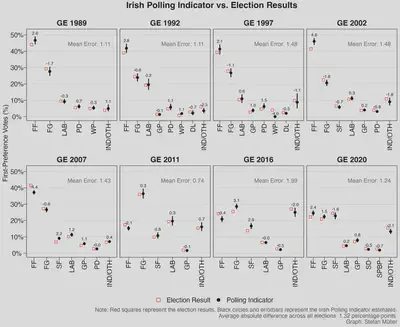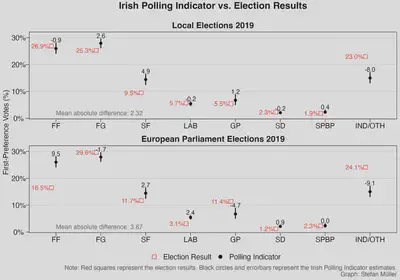Irish Polling Indicator, update May 2024

The 2024 Local and European Parliament Elections are approaching fast. The obvious question is whether current polls about support for General Elections can predict the outcomes of these two “second-order” elections in less than a month. After summarising the current levels of party support, I compare Polling Indicator estimates to the results of General Elections as well as to the 2019 Local and European Parliament Elections. While the “poll of polls” at the end of a legislative cycle correspond fairly closely to results of General Elections between 1989 and 2020, the correlation with the outcomes of the 2019 Local and European Parliament elections is much lower. We should therefore be cautious about using current polls to predict the results of the upcoming Local and European Parliament Elections.
Current Levels of Party Support
In the latest Ireland Thinks poll released last week, immigration emerged as the second most important policy priority. Housing remains the most important issue, with over 50% of voters listing housing as one of their two top priorities. Sinn Féin has lost considerable support since the rise of immigration as a major political issue in the autumn of 2023, which went hand-in-hand with lower importantce of the cost of living crisis. Currently, Sinn Féin stands at 27.5% [95% uncertainty margins: 26–29], which is still three percentage points above their first-preference vote share in the 2020 general election. Fine Gael polls at 19.5% [17.5–21], within reach of their last election result of 20.9%. However, polls suggest that the resignation of former Taoiseach Leo Varadkar and his successor Simon Harris did not increase support for Fine Gael. In fact, Fine Gael is almost at the exact same levels as one year ago.
The main beneficiary of the rise of the immigration issue are Independents and Other Parties. Since the autumn of last year, their support has increased from around 12% to 18.5% [16.5–21] and slightly exceeded levels of support for Fianna Fáil [17.5%; 16–19]. The Social Democrats, Green Party, and Labour are currently at similar levels, all in the range of 3–5.5%. Aontú stands at 2.5% [2–3], Solidarity-PBP at 2% [1.5–2.5].
Polls Struggle to Predict “Second-Order” Election Results
Can we use recent vote intention surveys for the General Election as a predictor of Local and European Parliament Election results? To answer this question, I compare the Irish Polling Indicator estimates to the results of General Elections between 1989 and 2020, as well as to the 2019 Local and European Parliament Elections. The first plot shows the election results of parties (squares) along with the Irish Polling Indicator point estimates and 95% confidence intervals at the end of each electoral cycle. The numbers above the estimates show the percentage point difference between the election result and the Polling Indicator estimate.
Across all elections since 1989, the average difference between a party’s estimate and election result is 1.32 percentage points. In most cases, the first-preference vote share lies within the 95% confidence interval. Louwerse’s (2016: 552) assessment is still correct: “overall the aggregation of polls does give a fair indication of how parties will do on election day. […] In most cases [the Irish Polling Indicator] is better than the poorest poll and quite close (or even better than) to the best poll.”

The patterns for the last Local and European Parliament Elections in 2019 look very different. The second figure below shows that the average difference to the Polling Indicator was 2.32 percentage points for the Local, and 3.87 points for the European Parliament Election. The errors are around 2–3 times higher than for General Elections. For example, the first-preference vote share for Sinn Féin in the 2019 Local Elections was five percentage points lower than the Polling Estimator on the same day. In the 2019 European Parliament Elections, Fianna Fáil’s first-preference vote share of 16.5% in the European Parliament Elections was 9.5 points lower than their Polling Indicator estimate. Independent candidates and other parties were the huge beneficiaries in 2019. Their support was 8 (Local Election) and 9 (European Parliament) percentage points higher than the Polling Indicator estimate for independent candidates and other parties. Given the rising volatility in voting patterns and recent political developments, it is unlikely that the election results will mirror the Polling Indicator estimates in a month’s time.

PS: The Irish Polling Indicator celebrates its 10-year anniversary this month!
Author: Stefan Müller